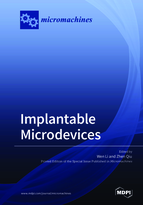Implantable Microdevices
A special issue of Micromachines (ISSN 2072-666X). This special issue belongs to the section "B:Biology and Biomedicine".
Deadline for manuscript submissions: closed (10 November 2018) | Viewed by 52913
Special Issue Editors
Interests: MEMS; microfluidics; biomimetic devices; implantable devices; sensors; integration and ackaging technologies
Special Issues, Collections and Topics in MDPI journals
Interests: biomedical optics; MEMS/MOEMS; imaging; wearable and implantable medical devices
Special Issues, Collections and Topics in MDPI journals
Special Issue Information
Dear Colleagues,
Implantable microdevices, providing accurate measurement of target analytes in animals and humans, have always been important in biological science, medical diagnostics, clinical therapy, and personal healthcare. Recently, there have been increasing unmet needs for developing high-performance implants that are small, minimally-invasive, biocompatible, long-term stable, and cost-effective. Therefore, the aim of this Special Issue is to bring together state-of-the-art research and development contributions that address key challenges and topics related to implantable microdevices. Applications of primary interest include, but are not limited to, miniaturized optical sensing and imaging tools, implantable sensors for detecting biochemical species and/or metabolites, transducers for measuring biophysical quantities (e.g., pressure and/or strain), and neural prosthetic devices.
This Special Issue solicits review articles, original research papers, and short communication on bio-optical sensor and imager, sensing and actuating structures and transducers, modeling, biocompatible materials and interfaces, fabrication techniques, advanced packaging and coatings, biotelemetry, electronics and algorithms that are inclusive of implantable microdevices themselves. Algorithms and hardware constructions designed to support implantable microdevices but not themselves implanted will not be considered. Authors are invited to contact the Guest Editors prior to submission if they are uncertain whether their work falls within the general scope of this Special Issue
Dr. Wen Li
Dr. Zhen Qiu
Guest Editors
Manuscript Submission Information
Manuscripts should be submitted online at www.mdpi.com by registering and logging in to this website. Once you are registered, click here to go to the submission form. Manuscripts can be submitted until the deadline. All submissions that pass pre-check are peer-reviewed. Accepted papers will be published continuously in the journal (as soon as accepted) and will be listed together on the special issue website. Research articles, review articles as well as short communications are invited. For planned papers, a title and short abstract (about 100 words) can be sent to the Editorial Office for announcement on this website.
Submitted manuscripts should not have been published previously, nor be under consideration for publication elsewhere (except conference proceedings papers). All manuscripts are thoroughly refereed through a single-blind peer-review process. A guide for authors and other relevant information for submission of manuscripts is available on the Instructions for Authors page. Micromachines is an international peer-reviewed open access monthly journal published by MDPI.
Please visit the Instructions for Authors page before submitting a manuscript. The Article Processing Charge (APC) for publication in this open access journal is 2600 CHF (Swiss Francs). Submitted papers should be well formatted and use good English. Authors may use MDPI's English editing service prior to publication or during author revisions.
Keywords
- Implants
- Implantable sensors
- Bio-optical sensor
- Bio-optical imager
- Transducers
- Neural prosthetic devices
- Biocompatible materials and interfaces
Related Special Issue
- Future Wearable and Implants in Micromachines (6 articles)







